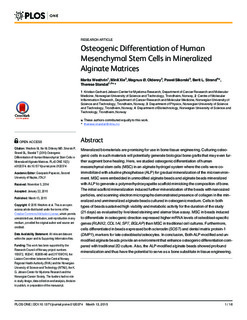| dc.contributor.author | Westhrin, Marita | |
| dc.contributor.author | Xie, Minli | |
| dc.contributor.author | Olderøy, Magnus Ø. | |
| dc.contributor.author | Sikorski, Pawel | |
| dc.contributor.author | Strand, Berit Løkensgard | |
| dc.contributor.author | Standal, Therese | |
| dc.date.accessioned | 2015-09-25T12:23:15Z | |
| dc.date.accessioned | 2015-10-05T08:39:39Z | |
| dc.date.available | 2015-09-25T12:23:15Z | |
| dc.date.available | 2015-10-05T08:39:39Z | |
| dc.date.issued | 2015 | |
| dc.identifier.citation | PLoS ONE 2015, 10(3) | nb_NO |
| dc.identifier.issn | 1932-6203 | |
| dc.identifier.uri | http://hdl.handle.net/11250/2178761 | |
| dc.description.abstract | Mineralized biomaterials are promising for use in bone tissue engineering. Culturing osteogenic
cells in such materials will potentially generate biological bone grafts that may even further
augment bone healing. Here, we studied osteogenic differentiation of human
mesenchymal stem cells (MSC) in an alginate hydrogel systemwhere the cells were coimmobilized
with alkaline phosphatase (ALP) for gradual mineralization of the microenvironment.
MSC were embedded in unmodified alginate beads and alginate beads mineralized
with ALP to generate a polymer/hydroxyapatite scaffold mimicking the composition of bone.
The initial scaffold mineralization induced further mineralization of the beads with nanosized
particles, and scanning electronmicrographs demonstrated presence of collagen in the mineralized
and unmineralized alginate beads cultured in osteogenicmedium. Cells in both
types of beads sustained high viability and metabolic activity for the duration of the study
(21 days) as evaluated by live/dead staining and alamar blue assay.MSC in beads induced
to differentiate in osteogenic direction expressed higher mRNA levels of osteoblast-specific
genes (RUNX2, COL1AI, SP7, BGLAP) thanMSC in traditional cell cultures. Furthermore,
cells differentiated in beads expressed both sclerostin (SOST) and dental matrix protein-1
(DMP1), markers for late osteoblasts/osteocytes. In conclusion, Both ALP-modified and unmodified
alginate beads provide an environment that enhance osteogenic differentiation compared
with traditional 2D culture. Also, the ALP-modified alginate beads showed profound
mineralization and thus have the potential to serve as a bone substitute in tissue engineering. | nb_NO |
| dc.language.iso | eng | nb_NO |
| dc.publisher | Public Library of Science | nb_NO |
| dc.title | Osteogenic differentiation of human mesenchymal stem cells in mineralized alginate matrices | nb_NO |
| dc.type | Journal article | nb_NO |
| dc.type | Peer reviewed | en_GB |
| dc.date.updated | 2015-09-25T12:23:15Z | |
| dc.source.volume | 10 | nb_NO |
| dc.source.journal | PLoS ONE | nb_NO |
| dc.source.issue | 3 | nb_NO |
| dc.identifier.doi | 10.1371/journal.pone.0120374 | |
| dc.identifier.cristin | 1246232 | |
| dc.description.localcode | © 2015 Westhrin et al. This is an open access article distributed under the terms of the Creative Commons Attribution License, which permits unrestricted use, distribution, and reproduction in any medium, provided the original author and source are credited. | nb_NO |
